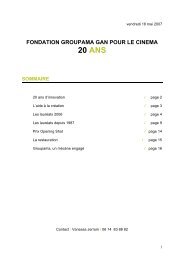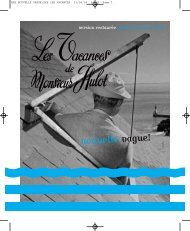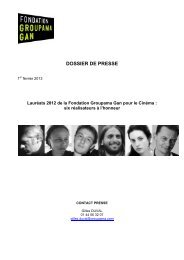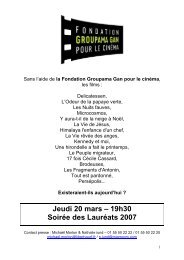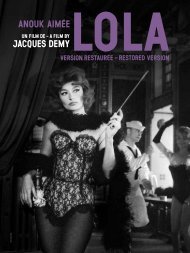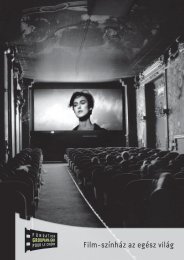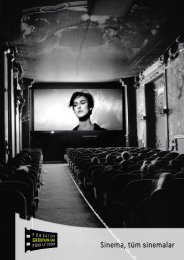duVoyage - Fondation Groupama Gan pour le Cinéma
duVoyage - Fondation Groupama Gan pour le Cinéma
duVoyage - Fondation Groupama Gan pour le Cinéma
You also want an ePaper? Increase the reach of your titles
YUMPU automatically turns print PDFs into web optimized ePapers that Google loves.
ting special effet requires that the film be rewound for a second exposure, generally on a black background.<br />
“This background was obtained by applying a black cache (or a piece of black material) to a portion of the scenery,<br />
or sometimes even to the <strong>le</strong>ns. Méliès often multiplied exposures – up to six times – to obtain the effect he was<br />
looking for: this was the case in Le Mélomane (“The Music Lover”, 1903) in which a musician uses te<strong>le</strong>graph<br />
wires as a musical instrument and catches his head in the wires to make notes. To make this work required<br />
use of the collage technique. Thanks to his studio, Méliès could also create effects by plunging a camera at a<br />
90 degree ang<strong>le</strong>.<br />
Above all, acting constantly as a man of theatre, Méliès mixed the cinematic with stage illusions that could<br />
well have been used in the Robert-Houdin theatre.<br />
Production<br />
“One day in 1931, <strong>le</strong>aving his toy shop for the evening, Georges Méliès, ageing and ruined, put on his best fitted<br />
coat to attend a banquet for three hundred peop<strong>le</strong>. Over dessert, M. Louis Lumière, an industrialist and<br />
member of the Institute, embraced him and pinned on his breast the Legion of Honor (...) saying: “I salute in<br />
you as the inventor of the cinematographic show.” Which amounted to stating that, whi<strong>le</strong> Louis Lumière had<br />
invented an excel<strong>le</strong>nt moving picture camera, the cinématographe, Georges Méliès had invented cinema itself.<br />
Cinema being not the simp<strong>le</strong> abbreviation of a trade mark, but a new genre of show, where stage-setting and<br />
production were everything”.<br />
Méliès’ film production was as much about the use of new tools (scenario, scenery, actors, make-up...) as the<br />
editing process (within the image).<br />
Georges Méliès, by Georges Sadoul – Seghers – 3 e edition<br />
Here again, Georges Méliès thought and acted as a man of the theatre and as a magician. When his medium<br />
became cinema, he took the stage with him.<br />
From illustration to illusion<br />
Méliès made films from 1896 onwards. He started with shorts that were popular with the public of the era:<br />
current affairs, or comical scenes, characterised by a theatrical tone that would forever remain in his work.<br />
Increasingly, he favoured fairy-ta<strong>le</strong> subjects rich in “phantasmagorical illusions.” This did not prevent him,<br />
however, from making a film about the Dreyfus affair in 1889, where he portrayed scenes and personalities<br />
based on drawings that had been published in the press, or the Le Sacre d’Edouard VII (“The Coronation of<br />
Edward VII”), a film that was commissioned (not in the catalogue) and depicted the coronation of the King of<br />
England which had not yet taken place.<br />
At the beginning of the 20 th century, cinema began to move to fixed rooms, and to <strong>le</strong>ave behind the fields of<br />
the fairground. Méliès worked to produce longer and more comp<strong>le</strong>x films than those shown in fairgrounds.<br />
The years 1901-1904 were golden for Méliès: he was ab<strong>le</strong> to savour both artistic and financial success. His production<br />
diversified: popular entertainment (Joan of Arc, Kingdom of the Fairies), news events (The eruption<br />
of Mount Pelé, The Coronation of Edward VII), adaptation of classics (The adventures of Robinson Crusoe,<br />
Faust). A joke film such as L’homme à la tête de caoutchouc (“The man with the Rubber Head”) still surprises today.<br />
Méliès genius for décor is reminiscent of Robida or Gustave Doré, whi<strong>le</strong> his fantasies were the precursors of<br />
modern science fiction. He also made several films on the theme of travel: Voyage dans la lune (“A Trip to the<br />
Moon” 1902), Voyage à travers l’impossib<strong>le</strong> (“Voyage through the Impossib<strong>le</strong>” 1904), Les quatre cents farces du diab<strong>le</strong><br />
(“The Devil’s 400 jokes” 1906), Deux cent mil<strong>le</strong> lieues sous <strong>le</strong>s mers (“2000 Leagues under the Sea”, 1907).<br />
86<br />
A film factory for film-makers and a trademark: Star Film<br />
In 1896, Georges Méliès formed a partnership with Lucien Reulos, responsib<strong>le</strong> for filing for patents on the equipment<br />
they had designed together with Lucien Korsten, and created the Star Film trademark (20 th November) at<br />
the same time. But the partnership did not last, and Lucien Reulos and Georges Méliès parted ways at the end<br />
of 1897. Georges Méliès became the so<strong>le</strong> owner of the Manufacture de films <strong>pour</strong> cinématographes (Film factory for<br />
film-makers) which had not then been set up as a commercial venture. Its first offices were at 13 passage de l’Opéra,<br />
near his home on rue Chauchat.<br />
Méliès opened several offices. In London, Char<strong>le</strong>s Urban was responsib<strong>le</strong> for selling Star Film shots. Oscar Richeux<br />
(then Baltazar Abadal) headed an office in Barcelona, and Théophi<strong>le</strong> Pathé, brother of Char<strong>le</strong>s and Emi<strong>le</strong><br />
Pathé, represented Star Film in Berlin. Significantly, Méliès’ brother, Gaston, founded a subsidiary in the United<br />
States which quickly established its own laboratory.<br />
The Starfilm trademark can be found for the first time in Le Manoir du diab<strong>le</strong> (n o . 78-80, “The House of the Devil”),<br />
which also includes the “MR” trademark (for Méliès and Reulos) inscribed in a five-point star.<br />
The trademark also featured in films made in<br />
1897, at which time Reulos’ name also disappeared.<br />
Georges Méliès modified the trademark 15 times<br />
between 1896 and 1911: making the trademark on<br />
boxes used in Méliès’ scenery a precious aid in<br />
dating his films.<br />
Expansion and piracy in the United States<br />
At the beginning of the 20 th century, and looking to expand, Georges Méliès opened a subsidiary in New York<br />
at 204 East 38 th Street, to be headed by his brother, Gaston (1903). The new office was set up to protect his films<br />
from being il<strong>le</strong>gally copied, thanks to American copyright ru<strong>le</strong>s, and to enab<strong>le</strong> the direct sa<strong>le</strong> of copies, without<br />
the need for unscrupulous midd<strong>le</strong>-men. A Trip to the Moon, re<strong>le</strong>ased in October 1902, was il<strong>le</strong>gally copied immediately,<br />
and on a grand sca<strong>le</strong>. As a consequence, from 1902 onwards Méliès would make two negatives simultaneously,<br />
using two Lumière cameras linked together so that there was only one take. One of the negatives<br />
would be sent to New York for the American market, where it would be developed in the New York lab. In this way,<br />
he worked around the customs barriers devised by Edison.<br />
George Méliès adopted a second systematic procedure as of 25 June 1903, which was to deposit his films in the<br />
Library of Congress in Washington, which he did until 1909. (In 1909, Georges Méliès’ films were distributed<br />
by Gaumont. His six last films, made between 1911 and 1912, were commissioned by Pathé and were not branded<br />
Star Film).<br />
In 1908, Gaston Méliès <strong>le</strong>ft New York and opened a new production company in Chicago, the Méliès Manufacturing<br />
Company so that Star Film could meet the production quotas required by the Motion Picture Patents<br />
Company (MPPC).<br />
Gaston Méliès recounts how his brother’s business became international just as the cinema industry was beginning<br />
to organise itself in Europe and in the United States: “My brother Georges, who had launched his cinema<br />
activities back in 1896, sent me to the United States of America to defend his interests there. I arrived<br />
in New York for the first time in November 1902 and my son Paul joined me a few months later. We opened<br />
the American subsidiary of Star Film, my brother’s trademark, at n o . 204 East 38 th street in Manhattan. Before<br />
the office was set up, Méliès’ films, distributed by an American firm – Biograph – were systematically and il<strong>le</strong>gally<br />
copied. The trademark, a five-point star surrounded by the three words MELIES STAR FILM, was scratched,<br />
87






